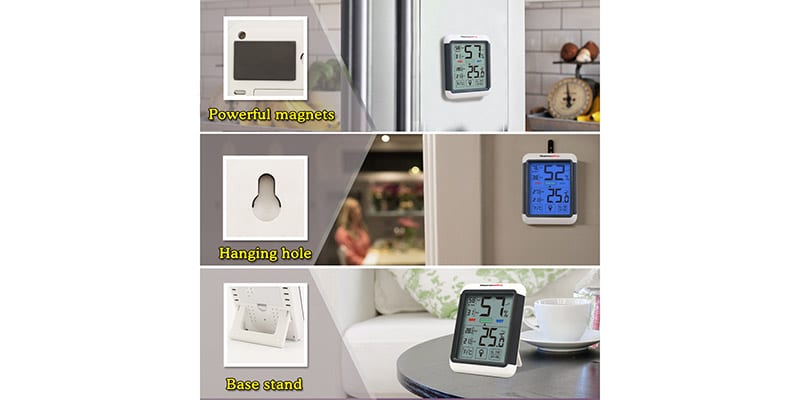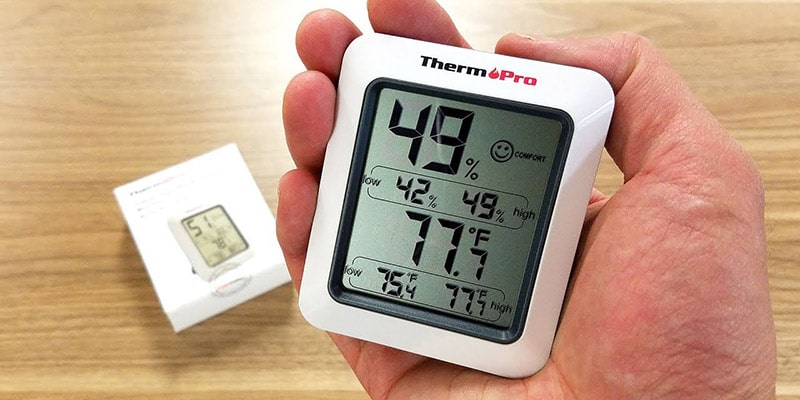The customer service team is always listening, taking notes, and quantifying complaints to ensure our products are continually improved. Due to selling directly to you, the customer, via Amazon, we can use product reviews to help us improve our existing products or help further development of new products.
Outdoor Thermometer - FAQs
Table of Contents
The manufacturers of the Indoor Outdoor thermometer devices offer more than just a temperature reading. Most of these units are able to provide extra facts such as the date, time zone, and even the humidity reading. Makers of the thermometers also ensure that the units are simple to use. They come with a few setup steps and often require the push of one or two buttons to change or monitor the settings. Here, you will find answers to some of the Indoor Outdoor thermometer questions that you might have.
If you need a wireless indoor and out thermometer that is packed with great benefits and features, then you should consider a ThermoPro device. It is mainly a great choice if you love a device that provides many different data points. The device will give you an accurate feel of what it is like in whichever room or area you place it. This can help you to avoid having to produce, grow bad or losing your crop that is inside the greenhouse. These devices most definitely outperform most of the devices in the market. They have a reputation for providing the best results consistently and being quite durable.
What Can Indoor Outdoor Thermometer Use For?

Why Should I Have An Indoor Outdoor Thermometer?
The main reason to get this type of thermometer is that it allows you to take readings without having to step out of the house. However, there are other uses. It measures more than temperature and can be used to measure humidity, barometric pressure, the humidity, and sometimes even gauge the state of our moon. The thermometer may also be used for measuring the temperatures of various areas indoors. For instance, if you have a cold storage area in the house, you can use this device. It might also be used to get accurate readings in a child’s room. This can help to ensure that your child is comfortable at all times. This is why this thermometer is so useful, it can help to keep your family, and even workers safe at all times when used in business premises.How to Properly Install a Home Thermometer?
• The Height
The height of a thermometer from the ground is crucial to how accurate it will be. Sensors need to be at about 6 feet off the ground. The land is a significant source of heat and cold since it retains heat long after the temperature around has changed. A reasonable distance off the ground ensures that your device is not taking readings of the earth’s temperature but that of the air.• Distance from the House
The sensor needs to be placed in a shady location. It should be located in an area protected from precipitation. However, it should not be too close to the house. This is because inside temperatures can leak out and affect its readings. For instance, devices placed near the windows, where most (temperature) loses occur, usually give measurements that are less accurate. It is recommended that it be placed at a distance, which is four times that of the closest building. This way, you can be sure no inside temperatures are being recorded by your device. For instance, if the roof is 20 feet high, the device has to be 80 feet away from the house.Keep it Away from Direct Sunlight
• The Airflow
Airflow is crucial if you wish to get proper readings. This is especially so for the humidity readings. The sensors need to be placed in a flat place that allows air to move freely. It should be in an area that is enclosed by objects or structures that prevent air from flowing freely. An exception to this will be if the local terrain is consistently hilly and thus it is hard to find a flat area to place the device.• The Pavement
Concrete and asphalt pavements both often store and slowly emit heat. In fact, it can get so hot in some places that you can actually fry an egg on the pavement. The sensors thus need to be about 100 feet from any paved driveway, road, or sidewalk. An area above grass or dirt is the best place to locate the sensors.• If You Cannot Get the Best Readings
If you live in a place where it is impossible to meet these optimal requirements for an accurate reading, you can still place the sensor. However, keep in mind that you are taking the reading of the air near your building and not the correct temperatures. In some cases, you will only see a slight variation. However, it can be huge depending on how many factors you manage to optimize. Try to shift it around until you find the most optimal location to place it.How long does it take a thermometer to get to the correct temperature?
How often should I calibrate a thermometer?
Manufacturer Recommendations
If you are using a ThermoPro device, it will come with instructions on how often you should calibrate it. You can then use the manual as a basis for how often you will calibrate your device.Before a Major Project
You might be planning to set up a home garden or trying to gauge whether it is the right time to start planting. This can be useful to ensure that when you get started on your project, you will do accurate readings. Calibrate the sensors and then lock them up until you are ready to start the project.After a Major Project
If you had to calibrate the device for a given project, then you need to calibrate the equipment after testing. This way, you can decide whether the results were accurate or not. It will also help you to determine the margin of error for your project.After Being Knocked Over
This is because the instruments will surely have taken a hit that could overload the internal protection. Recalibrate the device and check it for safety. If any parts appear damaged, it will most likely not be able to offer accurate readings in the future.Requirements of a Project
In some cases, it will be the requirements of the project to have calibrated and certified devices. While it might not be stated in some cases, it will usually be expected. Failure to fulfill it may put the integrity of the whole project at risk.Monthly
This is one of the most optimal times to calibrate your device. If you often take critical measurements, this seems like a good idea. For instance, if you use the device in a home cooling room, you do not want to find that food rotted due to inaccurate readings.Annually
If most of the measures that you take are not so critical, this can be the right interval in which to calibrate the device. It is the right balance between cost and prudence. However, it must never go above this for the accuracy of the device.Never
If you use the device for gross checks and have other equipment to refine the readings, you might never have to. However, if you do this, you will never have confidence in your results.What Can Be Measured In A Thermopro Indoor Outdoor Thermometer?
ThermoPro Indoor/Outdoor Thermometer Key Features:
- A Touchable backlight display for ease of viewing
- A 433 MHZ transmitter that has a range of 200 feet
- Trend arrows to allow adjustments to be made in advance
- Display 24 hours, all time, and highs and lows in temperature and humidity readings
- A rechargeable, weather-resistance outdoor sensor that has a full charge that lasts a year
- It can sync up to three sensors outdoors, which can help to monitors various locations
- Indoor temperature range of 4~158°F
- Outdoor temperature range of 58~158°F
- A humidity Range of 10~99%
- A temperature Tolerance of ±2.0°F
- A humidity tolerance of ±2% from 30% to 80% and ±3% below 30% and above 80%
If you need a wireless indoor and out thermometer that is packed with great benefits and features, then you should consider a ThermoPro device. It is mainly a great choice if you love a device that provides many different data points. The device will give you an accurate feel of what it is like in whichever room or area you place it. This can help you to avoid having to produce, grow bad or losing your crop that is inside the greenhouse. These devices most definitely outperform most of the devices in the market. They have a reputation for providing the best results consistently and being quite durable.














